



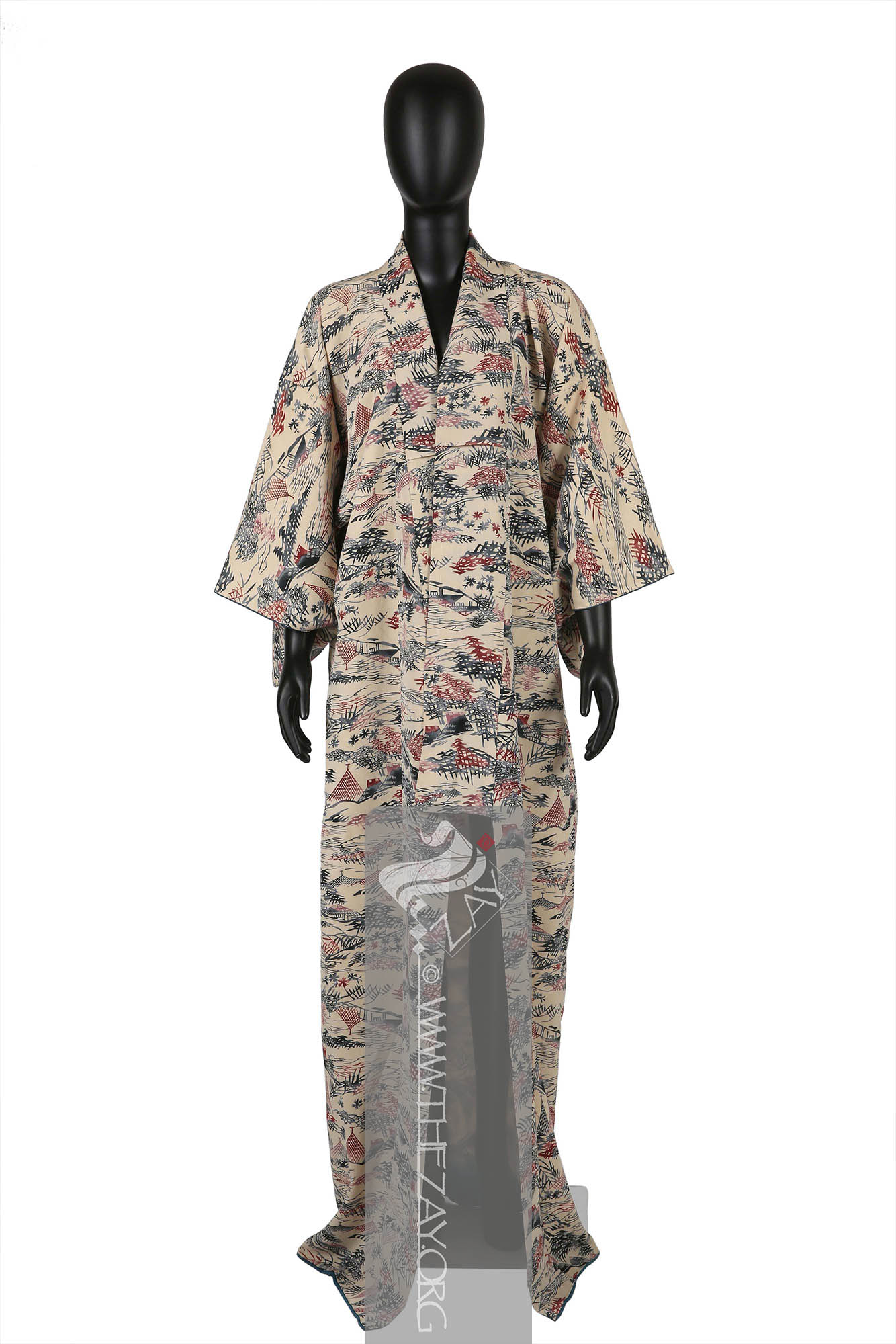
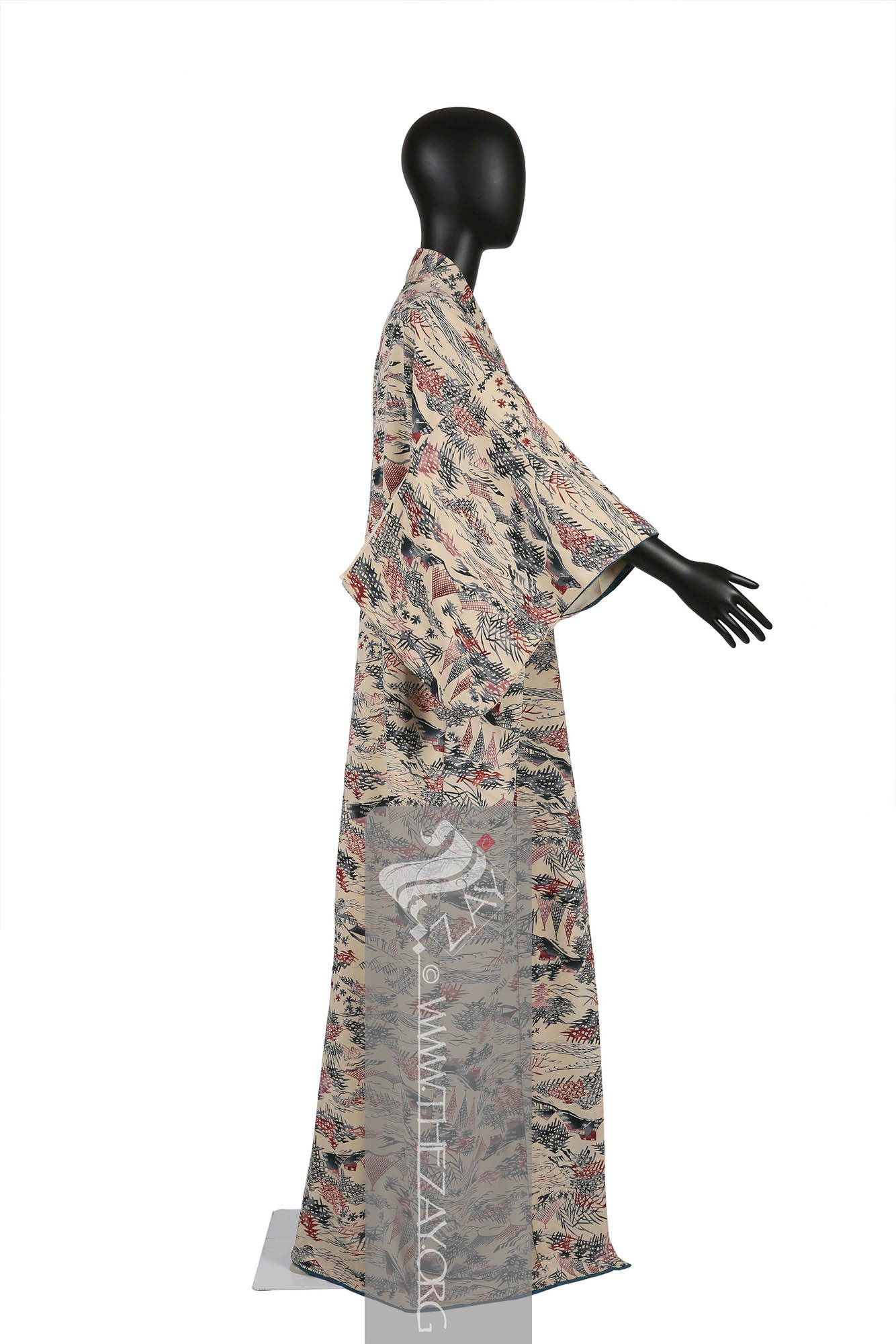
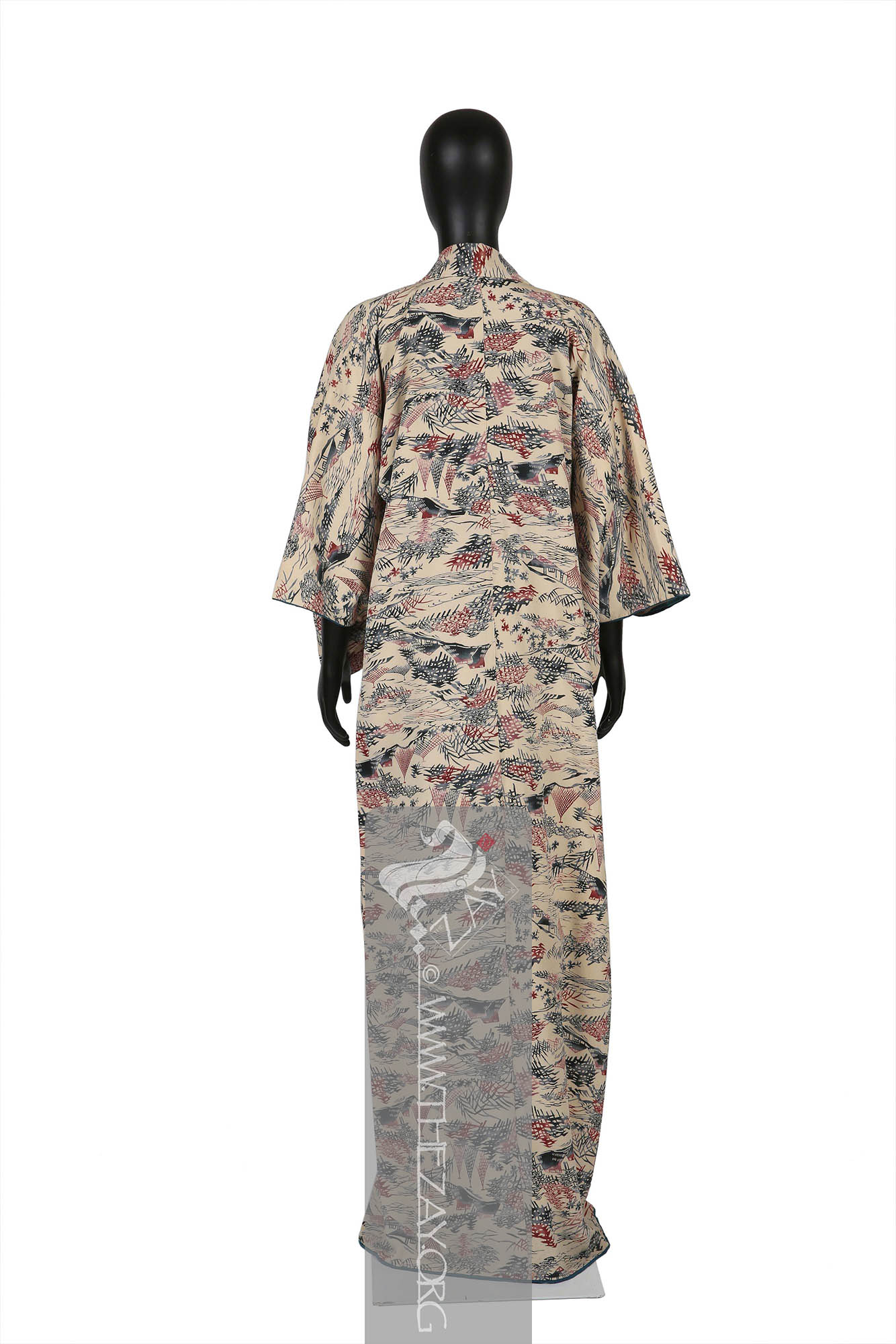
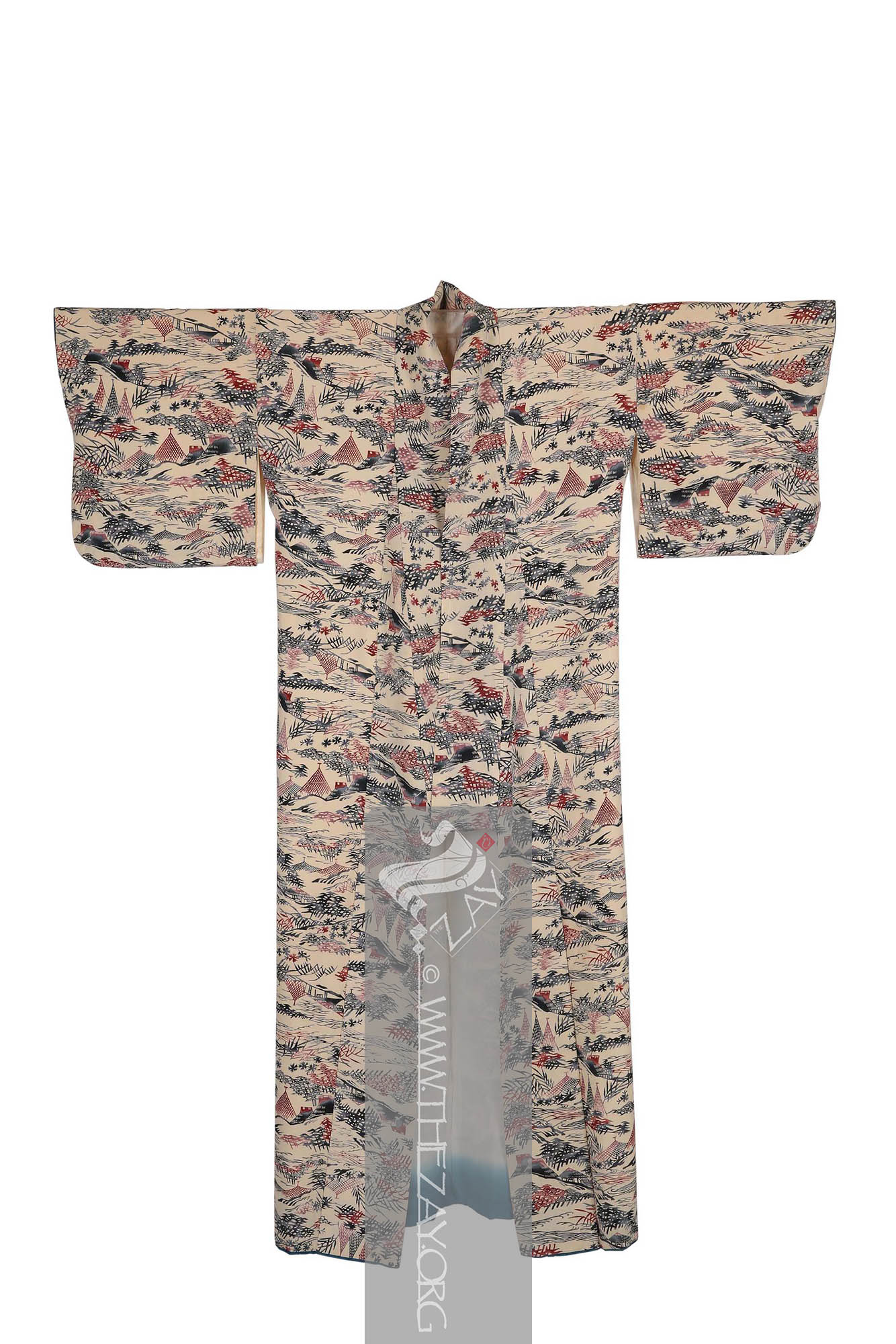
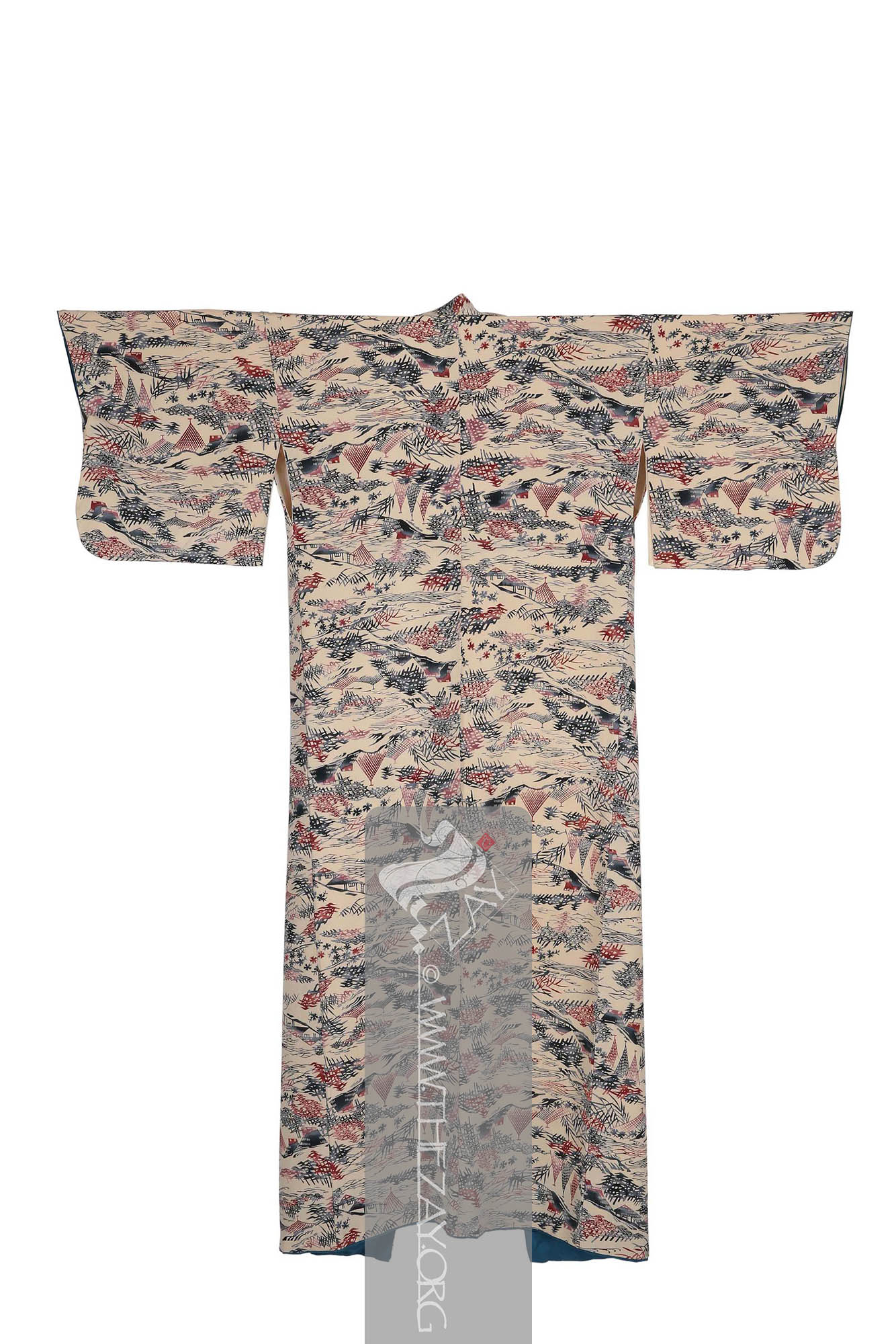
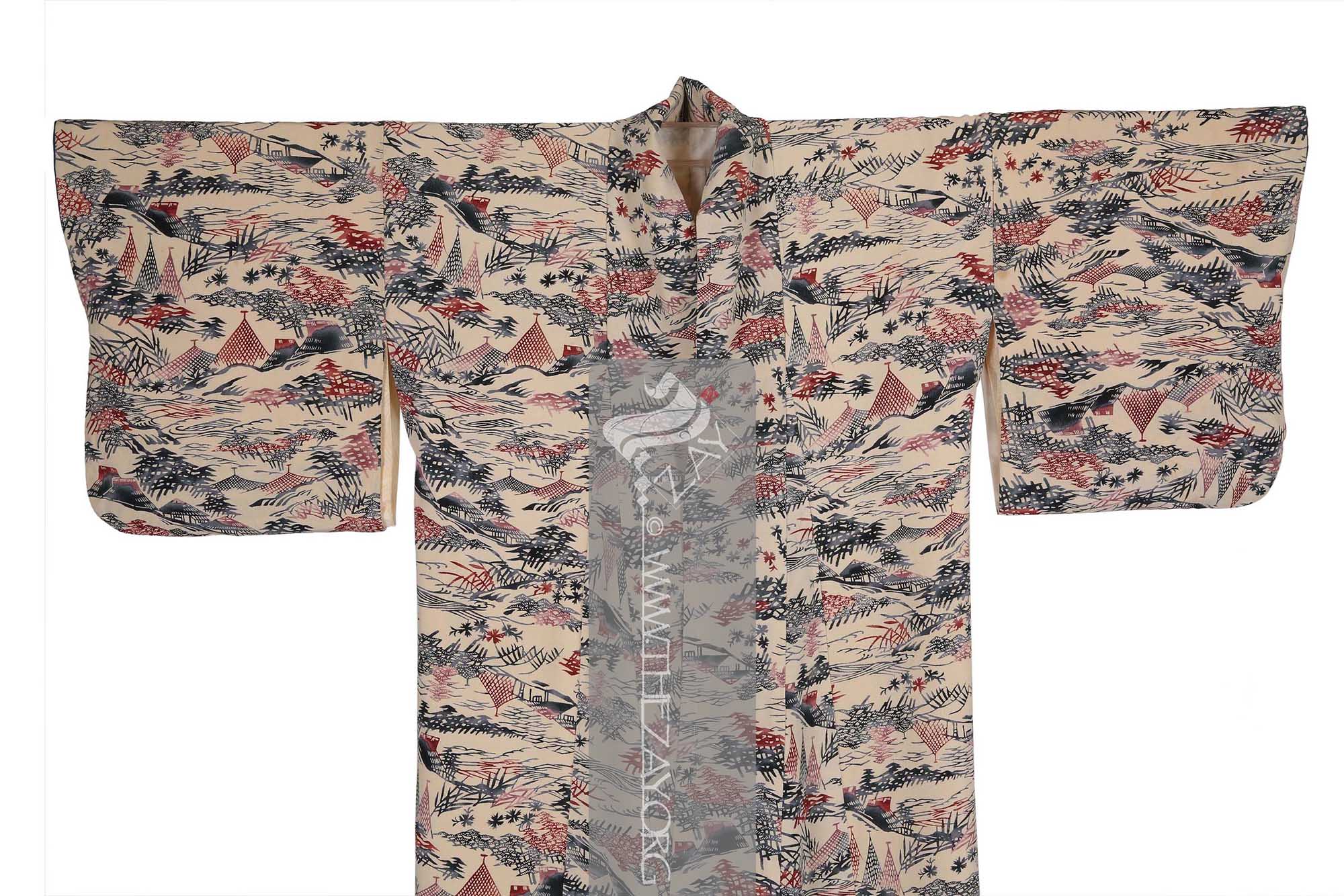
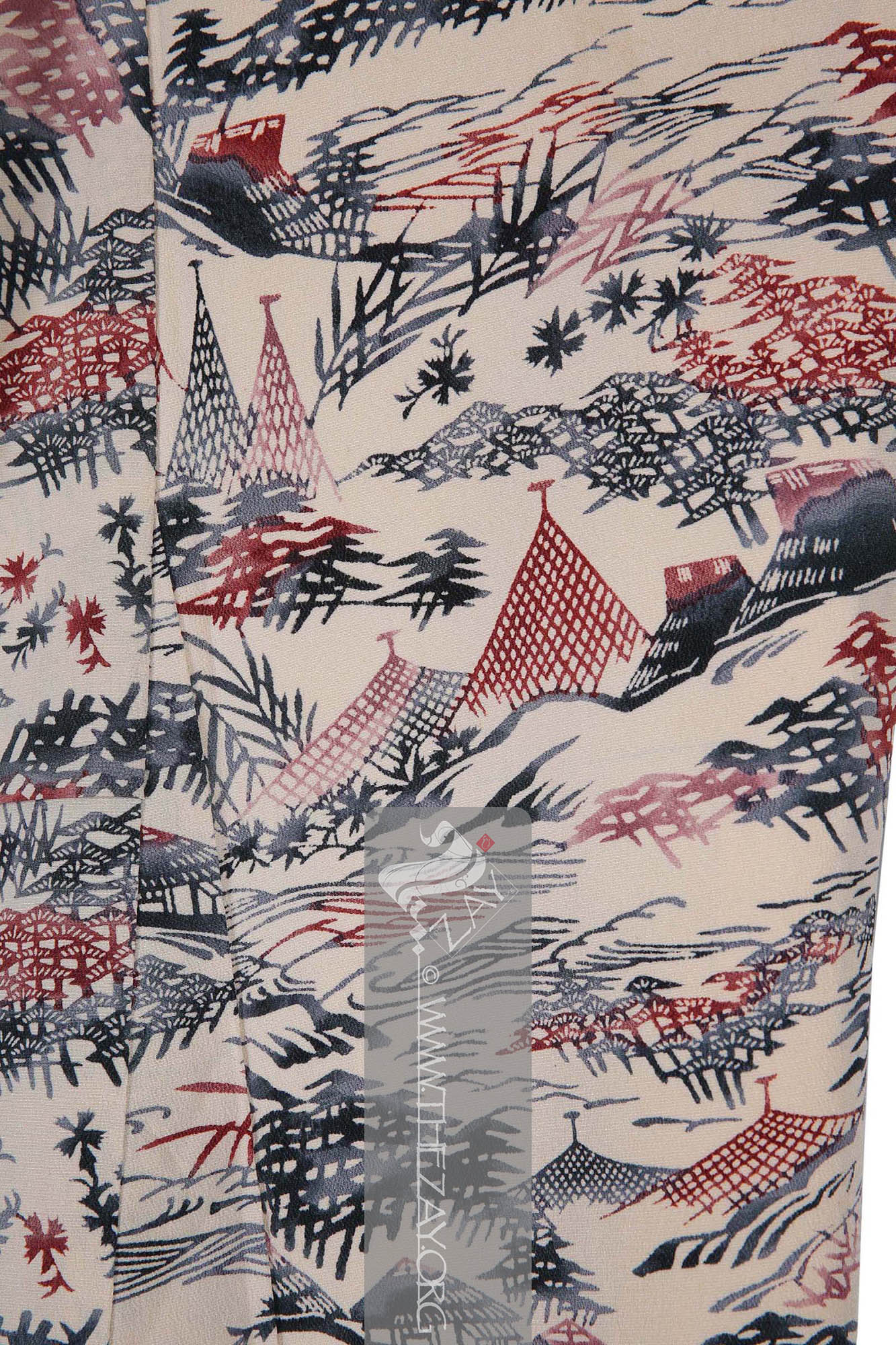
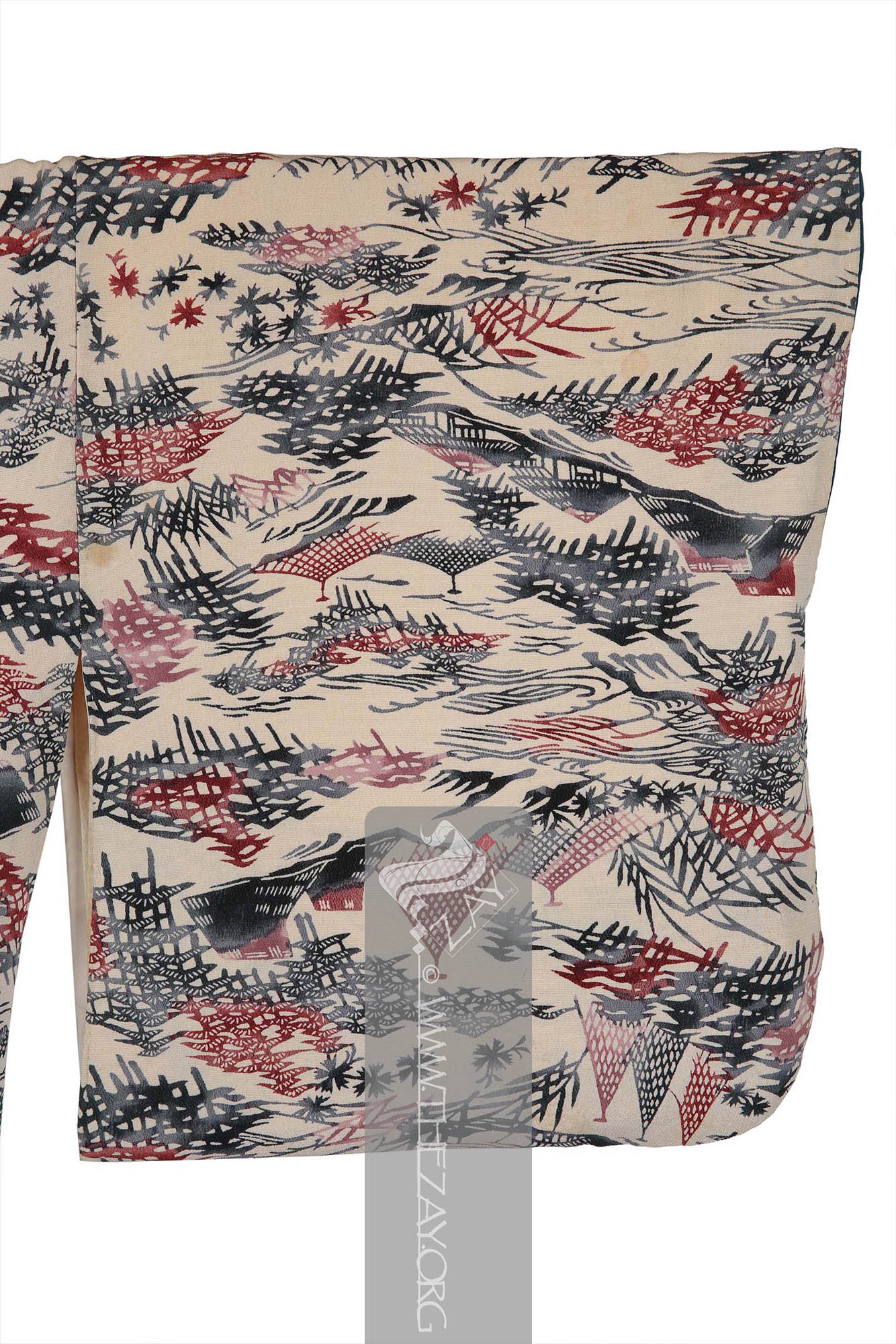

| Local Name | Komon_kimono |
| Object Category | Overgarment |
| Gender | Female |
| Place Of orgin | Asia |
| Region | Japan |
| Object Range | Japan |
| Dimensions | Length: 163 cm Width: 128 cm |
| Materials | Silk |
| Technique | Hand Stitched Print Woven |
| Motif | Floral Waves Animal |
| Provenance | Purchased, Victoria and Albert Museum sale of vintage kimonos in 2015 |
| Location | The Zay Zay: (Arabic: costume, Pl. azyaā’), a set of clothes in a style typical of a particular country or historical period. Initiative |
| Status | In Storage |
| ZI number | ZI2020.500747 ASIA |
Object Note
A set of three kimonos acquired from the V&A store during a visit to ‘Kimono Kimono: (Japanese: ki : wearing, mono: thing, Singular: Kimono) A traditional Japanese long loose robe with wide sleeves tied with a sash around the waist. Presently it is the national dress of Japan. : Kyoto to Catwalk’ exhibition, held in 2020, along with (ZI2020.500745 ASIA, and ZI2020.500746 ASIA).
Object History
This is a genuine Japanese vintage (kimono
Kimono: (Japanese: ki : wearing, mono: thing, Singular: Kimono) A traditional Japanese long loose robe with wide sleeves tied with a sash around the waist. Presently it is the national dress of Japan. ) made in Japan and was originally a part of the Victoria and Albert Museum collection until 2015. It was restored and put on sale by the V&A where Dr. Reem Tariq
Ṭariq: (Arabic; Synonym: tulle_bi_talli
Tūlle_bi_tallī: (French: Tulle – a city in France where fine material for veil was first made; Turkish: tel – wire; Synonym: tariq; talli; badla; khus_dozi ), series of small metal knots made on a woven net ground as embellishment. The term is commonly used in the North African Arab region specifically in Egypt. Ṭariq: (Arabic; Synonym: tulle_bi_talli
Tūlle_bi_tallī: (French: Tulle – a city in France where fine material for veil was first made; Turkish: tel – wire; Synonym: tariq; talli; badla; khus_dozi ), series of small metal knots made on a woven net ground as embellishment. The term is commonly used in the North African Arab region specifically in Egypt.
Object Features
This is beige (komon_kimono
Komon_kimono: A type of kimono that is characterized by its repeating pattern covering the entire fabric. Typically made of silk it is often worn for everyday occasions. The patterns on a komon kimono range from simple designs to intricate motifs and can be dyed in a variety of colours. ) made of Japanese (chirimen
chirimen: A Japanese crepe
Crepe: (Latin: crispus; Old French: crespe – curled or frizzed), is a lightweight, crinkled fabric with a pebbled texture woven from a hand spun untreated or ‘in the gum’ silk yarn.
The main fabric of the kimono
Kimono: (Japanese: ki : wearing, mono: thing, Singular: Kimono) A traditional Japanese long loose robe with wide sleeves tied with a sash around the waist. Presently it is the national dress of Japan. as mentioned earlier is Japanese crepe
Crepe: (Latin: crispus; Old French: crespe – curled or frizzed), is a lightweight, crinkled fabric with a pebbled texture woven from a hand spun untreated or ‘in the gum’ silk yarn.
A (komon_kimono Komon_kimono: A type of kimono that is characterized by its repeating pattern covering the entire fabric. Typically made of silk it is often worn for everyday occasions. The patterns on a komon kimono range from simple designs to intricate motifs and can be dyed in a variety of colours. ) like this was traditionally used for casual wear.
Although in a very muted colour, the triple opening in the sleeves, and the broad collar suggest that it is a women’s kimono Kimono: (Japanese: ki : wearing, mono: thing, Singular: Kimono) A traditional Japanese long loose robe with wide sleeves tied with a sash around the waist. Presently it is the national dress of Japan. . A metal snap button set is sewn in the middle of the collar possibly to help keep it folded while wearing it. The original lining of the piece is in ivory satin Sātin: (Arabic: Zaytuni: from Chinese port of Zayton in Quanzhou province where it was exported from and acquired by Arab merchants), one of the three basic types of woven fabric with a glossy top surface and a dull back. Originated in China and was fundamentally woven in silk. dyed in an indigo Indigo: (Latin: Indigo – India, synonym: nil Nīl: (Latin: indigo), Arabised term for Indigo, a natural dye belonging to the ‘Indigofera Tinctoria’ species of plants that have been cultivated in East Asia, Egypt, India, and Peru since antiquity. According to Pliny the Elder, it was named after India as it was the source of the dye.), a natural dye belonging to the ‘Indigofera Tinctoria’ species of plants that has been cultivated in East Asia, Egypt, India, and Peru since antiquity. According to Pliny the Elder, it was named after India as it was the source of the dye. gradient at the bottom hem. The shoulders and the sleeves have an extra layer of lining in the same top fabric.
The entire piece is hand stitched with white silk floss Floss: (Old French: flosche – nap of velvet), is a type of silk fibre obtained from the cocoons of wild silkworms. It is characterized by its long, fluffy fibers that are not tightly woven, making it ideal for use in various textile applications such as embroidery, lace-making, and sewing. thread which creates a visual element along its hemlines especially the sleeves and the bottom. With a thick fabric, an educated conclusion could be drawn that this piece was possibly made for a mildly cool autumn or spring as kimonos for winter were mostly made of thicker material and were also padded while summer kimonos were mostly constructed of very light materials like cotton and linen.
While the origin of certain techniques and methods in textiles like satin_stitch Satin_stitch: (Synonym: Damask Stitch), is a type of flat embroidery stitch that creates a satin like smooth and shiny surface by closely spaced stitches, covering an entire area or shape. embroidery can be traced to China, and its spread across the world could be attributed to the Silk Road, other similar techniques and styles are believed to have originated independently in different regions of the world almost simultaneously in human history possibly from necessity and convenience.
Though The Zay Zay: (Arabic: costume, Pl. azyaā’), a set of clothes in a style typical of a particular country or historical period. Initiative is concerned mainly with the dress and adornment heritage of the Arab world, it does include in its collection articles from areas outside the region. These tend to be collected to illustrate specific shared elements and influences attesting that the Arab world never existed in a vacuum. It constantly drew, and continues to draw, inspiration and influences from the cultures it comes in contact with be it through trade or geopolitical circumstances, especially those countries within the old silk route.
Therefore, one cannot but draw parallels between many techniques used in such garments, such as (couching
Couching: (Latin: collocare – Place together), in needlework and embroidery couching is a technique in which yarn or other materials are laid across the surface of the ground fabric and fastened in place with small stitches of the same or a different yarn Tallī: (Turkish: tel – wire, string), Gulf Arab – a woven braided trimming made with metal wire, threads and ribbons often sewn on detachable panels used as embellishments. Other – (Synonym: tulle_bi_talli
Tūlle_bi_tallī: (French: Tulle – a city in France where fine material for veil was first made; Turkish: tel – wire; Synonym: tariq; talli; badla; khus_dozi ), series of small metal knots made on a woven net ground as embellishment. The term is commonly used in the North African Arab region specifically in Egypt.
The kimono Kimono: (Japanese: ki : wearing, mono: thing, Singular: Kimono) A traditional Japanese long loose robe with wide sleeves tied with a sash around the waist. Presently it is the national dress of Japan. also shows an example of similarities that can be drawn from the pattern of Arab women’s overgarment or the (thawb Thawb: (Arabic: thawb, Pl. Athwāb/thībān), can be pronounced thobe Thobe: (Arabic: thawb, Pl. Athwāb/thībān), can be pronounced thawb or tobe Tobe: (Arabic: thawb, Pl. Athwāb/thībān), can be pronounced thawb or thobe based on locale. The standard Arabic word for ‘fabric’ or ‘garment’. It can refer to a qamīs-like tunic worn by men and women in the Arabian Peninsula, Iraq, the southern and south-western ports and islands of Iran, and some countries in East and West Africa. More specifically, it can refer to the square-shaped Bedouin overgarment worn by women. based on locale. The standard Arabic word for ‘fabric’ or ‘garment’. It can also refer to a qamīs-like tunic worn by men and women in the Arabian Peninsula, Iraq, the southern and south-western ports and islands of Iran, and some countries in East and West Africa. More specifically, it can refer to the square-shaped Bedouin overgarment worn by women. or tobe Tobe: (Arabic: thawb, Pl. Athwāb/thībān), can be pronounced thawb or thobe based on locale. The standard Arabic word for ‘fabric’ or ‘garment’. It can refer to a qamīs-like tunic worn by men and women in the Arabian Peninsula, Iraq, the southern and south-western ports and islands of Iran, and some countries in East and West Africa. More specifically, it can refer to the square-shaped Bedouin overgarment worn by women. based on locale. The standard Arabic word for ‘fabric’ or ‘garment’. It can also refer to a qamīs-like tunic worn by men and women in the Arabian Peninsula, Iraq, the southern and south-western ports and islands of Iran, and some countries in East and West Africa. More specifically, it can refer to the square-shaped Bedouin overgarment worn by women in the Arabian Gulf region. ), common to the Gulf region constructed of three uncut panels of broad clothes forming the central body panel and the side sleeve panels very similar in shape to the kimono Kimono: (Japanese: ki : wearing, mono: thing, Singular: Kimono) A traditional Japanese long loose robe with wide sleeves tied with a sash around the waist. Presently it is the national dress of Japan. .
More Info
Katazome is a traditional Japanese textile printing technique that utilizes stencils to create intricate and detailed designs on fabric. The word "katazome" translates to "stencil dyeing" in English, and the technique involves creating a stencil out of paper or other materials and then applying a resist paste to the fabric through the stencil. Once the paste has dried, the fabric is dyed, and the areas where the resist paste was applied remain undyed, creating a pattern on the fabric.
Katazome stencils are typically made using a combination of hand-carving and off-late machine-cutting techniques. The stencils themselves can be highly detailed, with intricate designs and patterns that can take weeks or even months to create. The resist paste used in katazome can also vary depending on the desired effect, with some pastes being more resistant to dye than others.
During the Edo period (1603-1868), katazome became a popular art form among the common people in Japan, and various regional styles of the technique emerged. In addition to clothing, katazome was used to create a wide range of household items such as curtains, bedding, and tablecloths. The intricate designs and vibrant colours of katazome made it a highly sought-after craft, and the popularity of the technique continued to grow.
Links